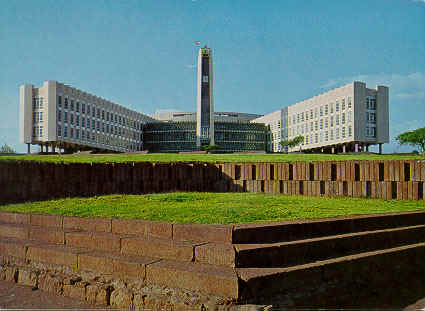![]() Mystical
Ethiopia
Mystical
Ethiopia ![]()
Land and Resources | Climate | Culture | Population | History | Historical Places | Religions | Government
Mystical Ethiopia | Addis Ababa | Economy | Emperor Haile Selassie | More Pictures
|
Land and Resources | Climate | Culture | Population | History | Historical Places | Religions | Government Mystical Ethiopia | Addis Ababa | Economy | Emperor Haile Selassie | More Pictures |
|
Addis Ababa The capital city Ethiopia. The Entoto Mountains are the legendary home of kings. Now, hundreds of years later, these shelter the "New Flower" capital 3000-yeas-old nation, Addis Ababa, the unofficial capital of the African continent. The city's museums and churches protect reminders of a rich heritage. There are archeological finds from two of the oldest known habitats of man, the Omo Valley and Melka Konture, and from the ancient seaport of Adulis. Addis Ababa is the permanent home of the Economic Commission for Africa and the Organization of Africa Unity. Africa Hall, gift of His Imperial Majesty, Haile Selassie I, plays host to frequent international conferences. Many worldwide organizations have regional offices here. Addis Ababa is the capital of a startlingly beautiful country. Just a few hours drive from the city is the lip of the plummeting Blue Nile Gorge, the hot springs of Ambo, the Menagesha National forest and the crater lakes of Debre Zeit. A bit farther are the Awash Game Park and the Great Rift Valleys lakes. History History records that in the early 19th century, Sahle Selassie, "negus' or king of Showa, stood on the crest of the Entoto Mountains and proclaimed that the one day his grandchildren would rule Ethiopia from Entoto, home of kings before the Arabs invasion of the 16th century. One of the Sahle Selassie's grandsons was Emperor Menilik II. Menilik II, who ruled Ethiopia from 1889 to 1913, had pushed the borders of Ethiopia far to the south and west and felt he needed a capital more central to the expanded Empire than was the former capital, Makale. He chose for his new center the hills his grandfather had spoken of many years before. Menilik II built two churches in the mountain, Bieta Mariam and Bieta Raguel, both of which can be visited today. he also began work in a town. Empress Taitu, however, quickly fell under the spell of the hot mineral springs which bubbled up in the valley below and made frequent pilgrimages down from the windy hillcrest. In 1893, she prevailed upon Menilik to move his " new flower" city down into the warmer valley near the springs. Menilik at that time introduced the fast growing silver-blue Australian eucalyptus trees to provide fuel for the town. These trees now cover the entire valley and the hills and much of the plateau beyond. After Menilik victory over the Italians at the Battle of Adwa in the 1896, diplomats from all over the world hurried to the new capital. A few years later negotiations started for the Franco-Ethiopian Railroad. Since then, Addis Ababa has grown spectacularly to a city. It is the economic, cultural and geographical center of the Empire, center of its network of all-weather roads with direct air connections to the rest of Africa, to Europe Asia and North America. Climate Addis Ababa delights in a tropical sun eased by cool highland breezes, the result of its position 9 degrees from the equator and 2400 meters above sea level. It has a climate that is comfortable. Nights are blanket cool. The temperature does drop in the rainy season when a topcoat as well as an umbrella may be necessary. But even in the season of the " big rains", June trough March, the sun shines every day, true to the Ethioipian boast of providing her visitors with " Thirteen Months of Sunshine". Other Cities Other major cities include Dire Dawa, Gonder, Nazaret, and Mekele.
|

|